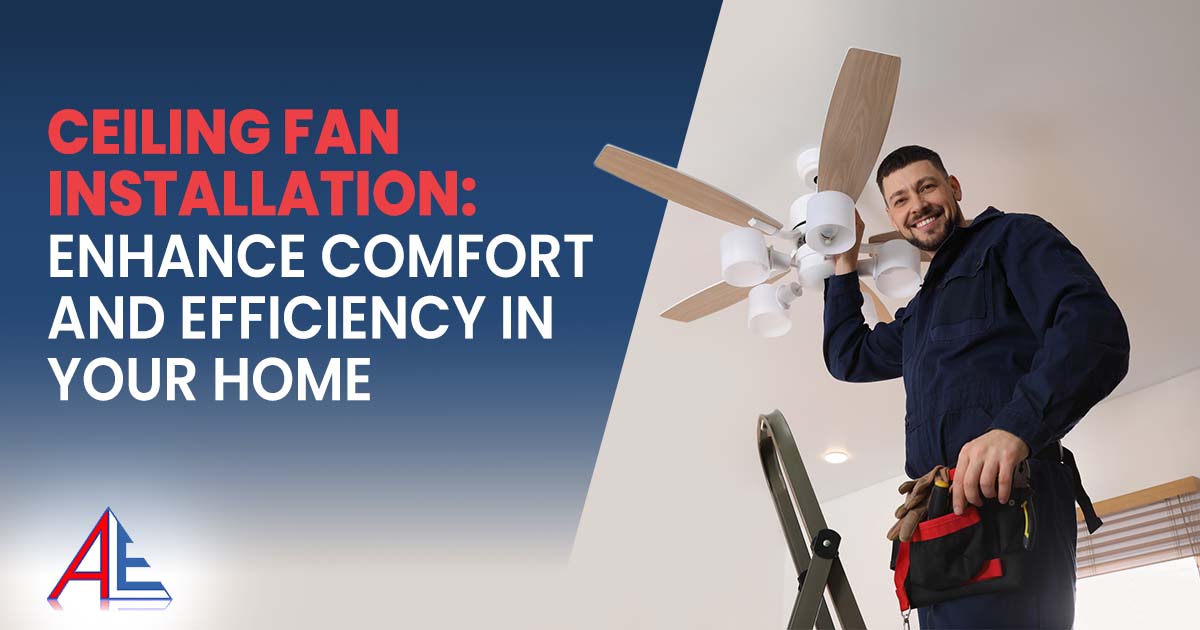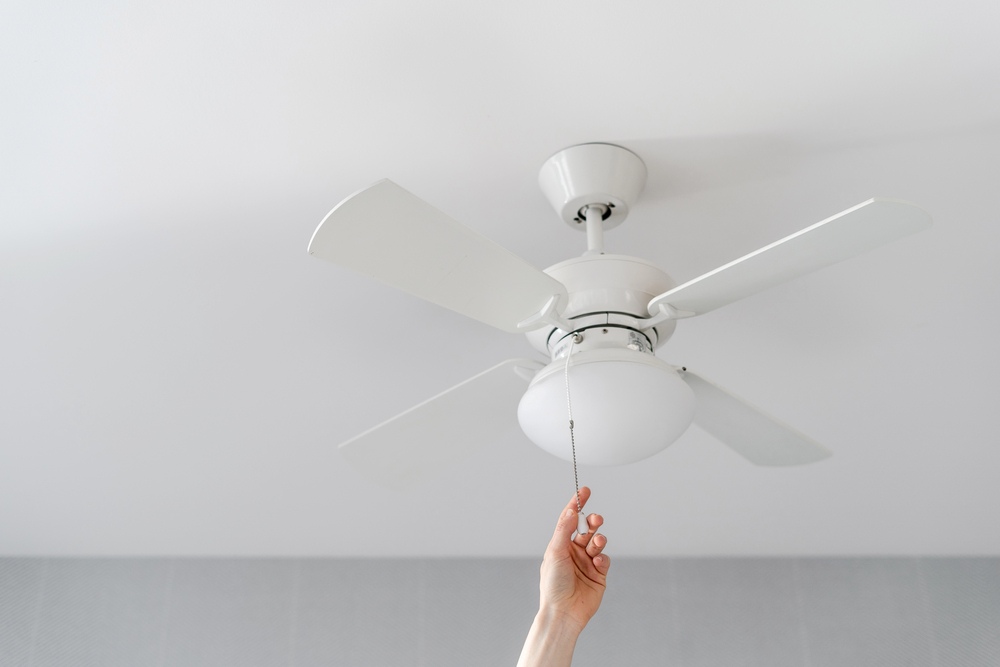Ceiling Fan Installation: Enhance Comfort and Efficiency in Your Home
Installing a ceiling fan is one of the most practical upgrades for improving indoor comfort and reducing energy costs. Whether in a living room, bedroom, or outdoor covered patio, ceiling fan installation helps homeowners maintain consistent airflow and lessen reliance on air conditioning. Anderson Lighting & Electric offers professional ceiling fan installation services that meet safety standards and manufacturer specifications.

Why Ceiling Fan Installation Matters
Ceiling fans serve a dual purpose: increasing comfort and improving energy efficiency. When installed correctly, ceiling fans help circulate air throughout a room, making spaces feel cooler in the summer and warmer in the winter.
Improve Indoor Comfort Year-Round
Ceiling fan blades are designed to move air effectively across the room. They create a wind-chill effect in warm months that helps lower perceived temperature. In colder seasons, reversing the blade direction pushes warm air downward from the ceiling, enhancing heating efficiency without adjusting the thermostat.
Reduce Energy Bills
Ceiling fan installation allows homeowners to reduce dependence on central air conditioning and heating systems. Adjusting the thermostat to a few degrees and using ceiling fans for air circulation can lower monthly utility bills. Fans use significantly less electricity than HVAC units, making them a cost-effective addition.
Increase Home Value and Appeal
Ceiling fans are a popular upgrade that can make a home more appealing to buyers and renters. Many ceiling fan models include integrated lighting, combining two functions in one fixture. Installing modern or designer ceiling fans can enhance the room’s visual appeal, contributing to a more updated and functional living space.
Types of Ceiling Fans for Home Installations
Choosing the right ceiling fan depends on the room’s dimensions, height, intended use, and environmental factors. Understanding the available types helps homeowners select a model that fits their practical and design needs.
Standard Ceiling Fans
Standard ceiling fans are the most common choice for residential installation. These models typically include a download and are designed for rooms with ceiling heights of 8 feet or more. They often come with built-in light fixtures, various blade finishes, and styles to match home interiors.
Dual-Motor Ceiling Fans
Dual-motor ceiling fans feature two adjustable fan heads mounted on horizontal bars from a central motor. They allow directional airflow control and are suited for large or open-concept rooms. Dual-motor fans are often chosen for their performance and unique design.
Outdoor Ceiling Fans
Outdoor ceiling fans are designed with moisture-resistant materials and weatherproof motor housings. These models are recommended for covered porches, patios, and gazebos. Outdoor fan installation must follow local building codes and should only use models rated for damp locations, depending on exposure.
Low-Profile Ceiling Fans
Also called flush-mount ceiling fans, low-profile fans are designed for lower than 8-foot ceilings. These fans mount directly to the ceiling without downloading, helping maintain safe clearance while providing adequate airflow. Low-profile fan installation is ideal for bedrooms, small offices, and low-ceiling living areas.
Smart Ceiling Fans
Smart ceiling fans offer advanced features like voice control, app integration, and programmable settings. These fans are compatible with smart home systems like Google Home, Amazon Alexa, and Apple HomeKit. Smart fan installation provides convenience and increased energy management through automation.
Preparing for Ceiling Fan Installation
Before installing a ceiling fan, it is essential to evaluate the room, assess electrical requirements, and understand necessary safety procedures. Proper planning ensures a smooth installation process and helps avoid common mistakes.
Assessing Room Size and Fan Requirements
Choosing the right ceiling fan size is essential for adequate airflow. Fan blade spans range from 29 inches for small rooms to over 60 inches for large or open-concept areas. Here are general sizing guidelines:
- Rooms up to 75 sq. ft. – 29″ to 36″ fan
- Rooms 76 to 144 sq. ft. – 36″ to 42″ fan
- Rooms 144 to 225 sq. ft. – 44″ to 50″ fan
- Rooms 225 to 400 sq. ft. – 50″ to 60″ fan
- Over 400 sq. ft. – 60″ + or multiple fans
In addition to size, consider ceiling height. Standard installations use a download to place the fan 7–9 feet above the floor. Sloped ceilings may require an angled mount kit.
Understanding Wiring and Electrical Considerations
Ceiling fan installation requires a properly rated ceiling box to support fan weight and movement. A standard light fixture box is not sufficient. The fan’s wiring must be compatible with the home’s electrical system.
Key points include:
- Use a UL-listed, fan-rated electrical box.
- Verify the circuit can handle the fan’s load.
- Identify whether the fan will operate on a single switch, dual switch (light and fan separately), or remote control.
It’s essential to follow the fan manufacturer’s wiring diagram precisely. When in doubt, hiring a licensed electrician is strongly recommended to ensure code compliance and avoid electrical hazards.
Safety Tips Before Installation
Working with electrical systems involves risk. These safety precautions help minimize potential injury or damage:
- Always shut off power at the circuit breaker.
- Use a voltage tester to confirm that the wires are not live.
- Secure ladders on a flat surface and avoid overreaching.
- Use insulated tools and wear protective gloves.
- Ensure the ceiling box is anchored securely to a joist or support brace.
Disclaimer: This section is for informational purposes only and does not replace professional advice. Anderson Lighting & Electric recommends contacting a licensed electrician for complex or high-ceiling installations.
Benefits of Professional Ceiling Fan Installation
While many homeowners can install ceiling fans independently, hiring a licensed professional provides added safety, efficiency, and peace of mind. Professional service is often the best choice for complex installations or rooms with high or sloped ceilings.
Ensure Code Compliance and Safety
Licensed electricians are trained to comply with local building and electrical codes. A professional installer ensures the ceiling fan is supported by the proper fan-rated junction box, securely mounted, and correctly wired. This reduces the risk of fire hazards, electrical issues, or ceiling damage.
Save Time and Avoid Common Installation Mistakes
Ceiling fan installation may seem straightforward, but even small mistakes—like using the wrong box, miswiring switches, or uneven blade installation—can result in malfunction or costly repairs. A qualified electrician completes the job efficiently, minimizing disruption and avoiding trial-and-error adjustments.
Specialized Tools and Expertise
Professional installers arrive with the necessary tools, equipment, and knowledge to handle any complications, including old wiring, damaged ceiling structures, or specialty fan configurations. This is especially important in older homes or when upgrading from a basic light fixture to a ceiling fan.
Warranty and Service Guarantees
Many ceiling fan manufacturers require professional installation for warranty coverage. By working with a licensed contractor like Anderson Lighting & Electric, customers often receive a service warranty that protects against installation defects or performance issues, offering long-term value.
Ceiling Fan Installation Cost Factors and Considerations
The cost of installing a ceiling fan varies depending on several factors, including the type of fan, installation complexity, and whether existing wiring is in place. Understanding these variables helps homeowners plan for both budget and service needs.
Type and Size of Ceiling Fan
Larger or more advanced fans typically require more time and precision to install. Smart ceiling fans, dual-motor units, and models with integrated lighting may take longer to assemble and wire, increasing labor costs.
Existing Electrical Setup
Installation costs are lower if the ceiling already has a fan-rated junction box and proper wiring. However, adding a new box, running new wiring, or installing a dual-switch setup increases the complexity and cost of the project.
Ceiling Height and Accessibility
Rooms with high, vaulted, or sloped ceilings often require additional safety equipment, scaffolding, or download extensions. These conditions can increase labor time and require specialized tools, resulting in higher installation fees.
Number of Units Installed
Due to the efficiency of scale, installing multiple ceiling fans in one appointment may reduce the cost per unit. Many electricians offer package rates or discounts for multi-room installations.

Geographic Location and Labor Rates
Rates for professional ceiling fan installation vary by region due to differences in labor costs and licensing requirements. Urban areas or regions with higher living costs may have higher service fees than suburban or rural locations.
Estimated Cost Range:
- Basic replacement (existing wiring and box): $100–$200
- New installation with wiring and box: $200–$500+
- Smart or specialty fan installation: $300–$600+
Note: These are general estimates. Always request a detailed quote from a licensed electrician before proceeding.
Ceiling Fan Maintenance Tips and Seasonal Use
Proper maintenance extends the life of a ceiling fan and ensures consistent performance. Additionally, adjusting fan direction seasonally can enhance indoor comfort and energy efficiency.
Routine Cleaning and Dusting
Dust buildup on fan blades can reduce efficiency and distribute allergens throughout the room. Clean the blades at least once a month using a microfiber cloth or a vacuum with a brush attachment. Always turn off the fan and wait for the blades to stop spinning before cleaning.
Tighten Screws and Check Blade Balance
Over time, screws on the blade arms, mounting bracket, and light fixture can loosen. Periodically check and tighten all fasteners to prevent wobbling or noise if the fan shakes during operation; a blade balancing kit may be needed.
Inspect Electrical Connections
Check for signs of wear, discoloration, or loose wires at the base and switches. If any issues are found, turn off the fan’s power and contact a licensed electrician for repair or replacement. Do not attempt to repair electrical components without proper training.
Use the Correct Direction by Season
Most ceiling fans feature a reversible motor that allows blades to rotate clockwise or counterclockwise. This feature can help regulate room temperature more efficiently throughout the year:
- Summer Mode (Counterclockwise): Pushes air downward to create a cooling breeze.
- Winter Mode (Clockwise): Circulates warm air trapped near the ceiling without creating a draft.
Adjust the direction using the switch on the fan motor or via remote/app if using a smart fan.
Replace Worn Components Promptly
Components such as pull chains, capacitors, or remotes may wear out over time. Replace defective parts using compatible manufacturer-approved components. When in doubt, consult a qualified technician.
Get Expert Ceiling Fan Installation from Anderson Lighting & Electric
Anderson Lighting & Electric provides professional ceiling fan installation services tailored to the needs of homeowners, renters, and property managers. With licensed electricians, code-compliant artistry, and a focus on safety, the team ensures each ceiling fan is installed efficiently and securely.
Whether replacing an outdated fixture or adding fans to multiple rooms, Anderson Lighting & Electric delivers reliable results with upfront pricing and responsive service. Customers can trust the team to handle complex wiring, high ceilings, and smart home integration with precision.
To schedule a ceiling fan installation or request a quote, contact Anderson Lighting & Electric today. Enjoy improved comfort, air circulation, and energy efficiency.
